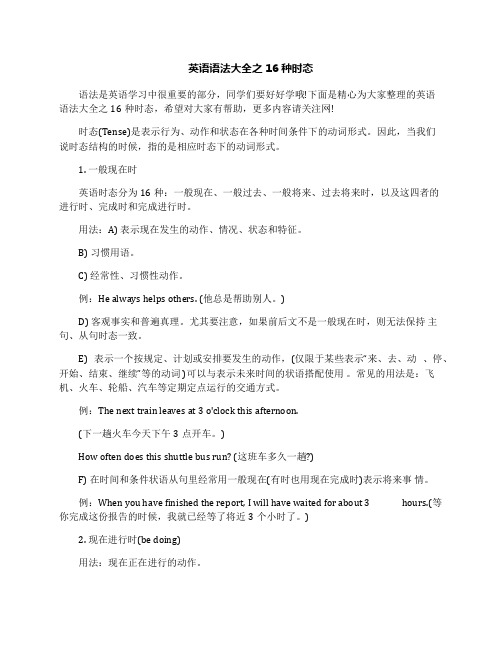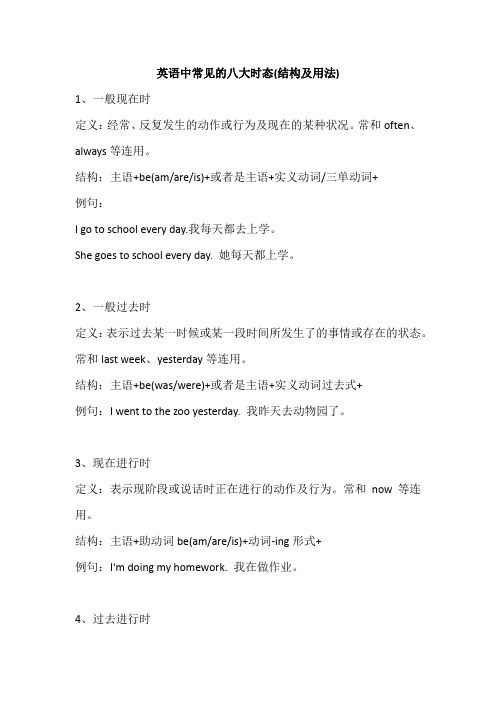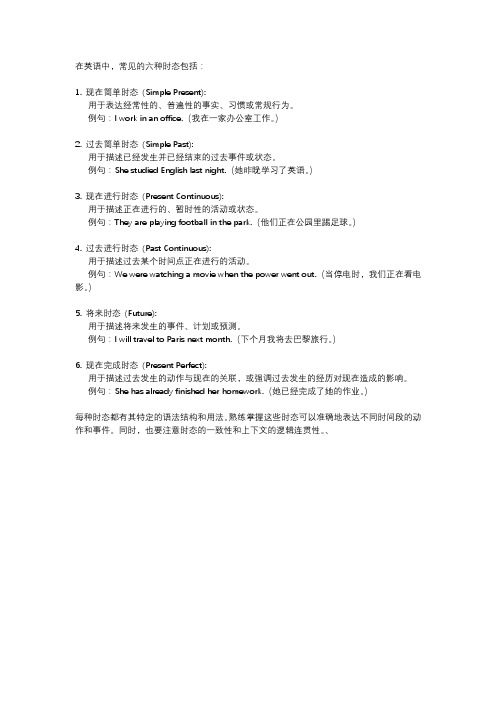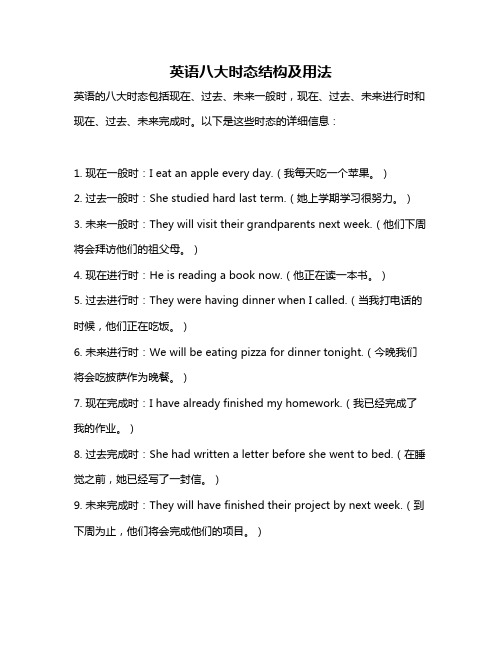英语中的各种时态及用法
英语语法大全之16种时态

英语语法大全之16种时态语法是英语学习中很重要的部分,同学们要好好学哦!下面是精心为大家整理的英语语法大全之16种时态,希望对大家有帮助,更多内容请关注网!时态(Tense)是表示行为、动作和状态在各种时间条件下的动词形式。
因此,当我们说时态结构的时候,指的是相应时态下的动词形式。
1. 一般现在时英语时态分为16种:一般现在、一般过去、一般将来、过去将来时,以及这四者的进行时、完成时和完成进行时。
用法:A) 表示现在发生的动作、情况、状态和特征。
B) 习惯用语。
C) 经常性、习惯性动作。
例:He always helps others. (他总是帮助别人。
)D) 客观事实和普遍真理。
尤其要注意,如果前后文不是一般现在时,则无法保持主句、从句时态一致。
E) 表示一个按规定、计划或安排要发生的动作,(仅限于某些表示“来、去、动、停、开始、结束、继续”等的动词 )可以与表示未来时间的状语搭配使用。
常见的用法是:飞机、火车、轮船、汽车等定期定点运行的交通方式。
例:The next train leaves at 3 o'clock this afternoon.(下一趟火车今天下午3点开车。
)How often does this shuttle bus run? (这班车多久一趟?)F) 在时间和条件状语从句里经常用一般现在(有时也用现在完成时)表示将来事情。
例:When you have finished the report, I will have waited for about 3 hours.(等你完成这份报告的时候,我就已经等了将近3个小时了。
)2. 现在进行时(be doing)用法:现在正在进行的动作。
3. 现在完成时(have done)用法:A) 表示动作到现在为止已经完成或刚刚完成。
例:I bought a new house, but I _________ my old one yet, so at the moment I have twohouses.A) didn't sell B) sold C) haven't sold D) would sell答案是C) haven't sold。
英语中常见的八大时态(结构及用法)

英语中常见的八大时态(结构及用法)1、一般现在时定义:经常、反复发生的动作或行为及现在的某种状况。
常和often、always等连用。
结构:主语+be(am/are/is)+或者是主语+实义动词/三单动词+例句:I go to school every day.我每天都去上学。
She goes to school every day. 她每天都上学。
2、一般过去时定义:表示过去某一时候或某一段时间所发生了的事情或存在的状态。
常和last week、yesterday等连用。
结构:主语+be(was/were)+或者是主语+实义动词过去式+例句:I went to the zoo yesterday. 我昨天去动物园了。
3、现在进行时定义:表示现阶段或说话时正在进行的动作及行为。
常和now等连用。
结构:主语+助动词be(am/are/is)+动词-ing形式+例句:I'm doing my homework. 我在做作业。
4、过去进行时定义:表示在过去某个时间点发生或进行的行为的事情。
常和at this time yesterday等或以when引导的谓语动词连用。
结构:主语+助动词be(was/were)+动词-ing形式+例句:When I got to the top of the mountain, the sun was shining. 我到达山顶时,阳光灿烂。
5、现在完成时定义:表示过去发生的动作对现在造成的影响或结果或过去的动作或状态持续到现在。
构成:主语+助动词(have/has)+动词过去分词+例句:I have lived here for more than twenty years. 我住在这儿二十多年了。
6、过去完成时定义:表示在过去某一时刻或动作以前完成了的动作,也可以说过去的时间关于过去的动作。
构成:主语+助动词(have/has)+动词过去分词+例句:She said she had never been to Paris. 她告诉我她曾去过巴黎。
英语中八种时态的具体用法

英语中八种时态的具体用法(1)一般现在时表示现阶段经常或习惯发生的动作或存在的状态,或说明主语的特征。
①一般现在时句子中常有的时间状语:often,usually,sometimes,always,every(day等),once/twice,a (week等), on (Sunday等),never,in the(morning等)。
如:They go to the Palace Museumonce a year.(他们每年去一次故宫)/ They oftendiscuss business in the evening.(他们经常在晚上商谈生意)②表示客观真理、事实、人的技能或现在的状态时句子里一般不用时间状语。
如:The earth turns round thesun.(地球绕着太阳转)/ Light travels faster thansound.(光传播比声音快)③表示十分确定会发生(如安排好的事情)或按照时间表进展的事情,用一般现在可以表达将来,句子中可以有将来时间。
如:The train for Haikou leaves at 8:00 in themorning.(开往汉口的列车上午8点开车)④在时间状语从句中(以when, after, before, while, until,as soon as等引导)与条件状语从句中(以if,unless引导),用一般现在时代替一般将来时,句子可以有将来时间。
如:Please ring me up as soon as you arrive inGermany.(你一到德国就给我打)/ If it rainstomorrow,we will have to stay at home.(如果明天下雨我们就只好呆在家)⑤一般现在时用于倒装句中可以表示正在发生的动作,动词以come, go为主。
如:Here comes the bus. (车来了)/ There goes the bell.(铃响了)。
英语中常见的六种时态的用法

在英语中,常见的六种时态包括:1. 现在简单时态(Simple Present):用于表达经常性的、普遍性的事实、习惯或常规行为。
例句:I work in an office.(我在一家办公室工作。
)2. 过去简单时态(Simple Past):用于描述已经发生并已经结束的过去事件或状态。
例句:She studied English last night.(她昨晚学习了英语。
)3. 现在进行时态(Present Continuous):用于描述正在进行的、暂时性的活动或状态。
例句:They are playing football in the park.(他们正在公园里踢足球。
)4. 过去进行时态(Past Continuous):用于描述过去某个时间点正在进行的活动。
例句:We were watching a movie when the power went out.(当停电时,我们正在看电影。
)5. 将来时态(Future):用于描述将来发生的事件、计划或预测。
例句:I will travel to Paris next month.(下个月我将去巴黎旅行。
)6. 现在完成时态(Present Perfect):用于描述过去发生的动作与现在的关联,或强调过去发生的经历对现在造成的影响。
例句:She has already finished her homework.(她已经完成了她的作业。
)每种时态都有其特定的语法结构和用法。
熟练掌握这些时态可以准确地表达不同时间段的动作和事件。
同时,也要注意时态的一致性和上下文的逻辑连贯性。
、。
高中英语:16种时态的谓语动词形式和具体用法

高中英语:16种时态的谓语动词形式和具体用法【1】一般现在时(do/does;is/am/are)①表示现在的情况、状态或特征。
例:He is a student.他是一个学生。
②表示经常性、习惯性动作。
例:He always helps others.他总是帮助别人。
③客观事实和普遍真理。
例:The earth moves the sun.地球绕着太阳转。
④表示一个按规定、计划或安排要发生的动作。
仅限于某些表示“来、去、动、停、开始、结束、继续”等的动词,可以与表示未来时间的状语搭配使用。
常见的用法是:飞机、火车、轮船、汽车等定期定点运行的交通方式。
例:The next train leaves at 3 o'clock this afternoon.下一趟火车今天下午3点开车。
⑤在时间、条件和让步状语从句中经常用一般现在(有时也用现在完成时)表示将的来事情。
(即:主将从现原则)例:I will call you as soon as I arrive at the airport.我一到机场就会给你打电话。
When you have finished the report, I will have waited for about 3 hours.等你完成这份报告的时候,我就已经等了将近3个小时了。
【2】现在进行时(am/is/are/doing)①表示此时此刻正在发生的事情。
例:He is listning to the music now.他现在正在听音乐。
②表示目前一段时间内一直在做的事情,但不一定此时此刻正在做。
例:I am studying computer this term.这个学期我一直在学习计算机。
③现在进行时可以表示将来的含义。
a. 瞬时动词的进行一定表将来。
例: I am leaving.我要离开了。
b. 持续动词的进行只有有将来的时间状语或有将来语境中才表将来。
英语八大时态结构及用法

英语八大时态结构及用法
英语的八大时态包括现在、过去、未来一般时,现在、过去、未来进行时和现在、过去、未来完成时。
以下是这些时态的详细信息:
1. 现在一般时:I eat an apple every day.(我每天吃一个苹果。
)
2. 过去一般时:She studied hard last term.(她上学期学习很努力。
)
3. 未来一般时:They will visit their grandparents next week.(他们下周将会拜访他们的祖父母。
)
4. 现在进行时:He is reading a book now.(他正在读一本书。
)
5. 过去进行时:They were having dinner when I called.(当我打电话的时候,他们正在吃饭。
)
6. 未来进行时:We will be eating pizza for dinner tonight.(今晚我们将会吃披萨作为晚餐。
)
7. 现在完成时:I have already finished my homework.(我已经完成了我的作业。
)
8. 过去完成时:She had written a letter before she went to bed.(在睡觉之前,她已经写了一封信。
)
9. 未来完成时:They will have finished their project by next week.(到下周为止,他们将会完成他们的项目。
)
以上是英语八大时态的结构及用法,希望对你有所帮助。
高考英语16种时态用法及例句精讲

高考英语16种时态用法及例句精讲1、一般现在时(do/does; is/am/are)①表示现在的情况、状态或特征。
例:He is a student.他是一个学生。
②表示经常性、习惯性动作。
例:He always helps others.他总是帮助别人。
③客观事实和普遍真理。
例:The earth moves the sun.地球绕着太阳转。
④表示一个按规定、计划或安排要发生的动作。
仅限于某些表示“来、去、动、停、开始、结束、继续”等的动词,可以与表示未来时间的状语搭配使用。
常见的用法是:飞机、火车、轮船、汽车等定期定点运行的交通方式。
例:The next train leaves at 3 o'clock this afternoon.下一趟火车今天下午3点开车。
⑤在时间、条件和让步状语从句中经常用一般现在(有时也用现在完成时)表示将的来事情。
(即:主将从现原则)例:I will call you as soon as I arrive at the airport.我一到机场就会给你打电话。
When you have finished the report, I will have waited for about 3 hours.等你完成这份报告的时候,我就已经等了将近3个小时了。
2、现在进行时(am/is/are doing)①表示此时此刻正在发生的事情。
例:He is listening to the music now.他现在正在听音乐。
②表示目前一段时间内一直在做的事情,但不一定此时此刻正在做。
例:I am studying computer this term.这个学期我一直在学习计算机。
③现在进行时可以表示将来的含义。
a. 瞬时动词的进行一定表将来。
例:I am leaving.我要离开了。
b. 持续动词的进行只有有将来的时间状语或有将来语境中才表将来。
例:I am travelling next month.下个月我要去旅行。
英语中的各种时态及用法

英语中的各种时态及用法英语的时态(tense)是一种动词形式,不同的时态用以表示不同的时间与方式。
是表示行为、动作和状态在各种时间条件下的动词形式。
因此,当我们说时态结构的时候,指的是相应时态下的动词形式。
英语时态分为16种:一般现在、一般过去、一般将来、过去将来时,以及这四者的进行时、完成时和完成进行时下面就英语中常见的八种基本时态进行阐述,其它的时态都是在这八种时态的基础上结合而成的。
一、一般现在时: 1.概念:经常、反复发生的动作或行为及现在的某种状况。
2.时间状语: always, usuall y, often,someti mes, everyweek (day, year, month…), once a week, on Sunday s, 3.基本结构:动词原形(如主语为第三人称单数,动词上要改为第三人称单数形式) 4.否定形式:am/is/are+not;此时态的谓语动词若为行为动词,则在其前加d on't,如主语为第三人称单数,则用does n't,同时还原行为动词。
5.一般疑问句:把be动词放于句首;用助动词do提问,如主语为第三人称单数,则用does,同时,还原行为动词。
6.例句:. It seldom snowshere. He is always readyto help others. Action speaks louder than words.二、一般过去时: 1.概念:过去某个时间里发生的动作或状态;过去习惯性、经常性的动作、行为。
2.时间状语:ago, yester day, the day before yester day, last week,last(year, night, month…),in1989,justnow,attheageof5,oneday,long long ago, once upon a time, etc. 3.基本结构:be动词;行为动词的过去式4.否定形式:was/were+not;在行为动词前加didn't,同时还原行为动词。
- 1、下载文档前请自行甄别文档内容的完整性,平台不提供额外的编辑、内容补充、找答案等附加服务。
- 2、"仅部分预览"的文档,不可在线预览部分如存在完整性等问题,可反馈申请退款(可完整预览的文档不适用该条件!)。
- 3、如文档侵犯您的权益,请联系客服反馈,我们会尽快为您处理(人工客服工作时间:9:00-18:30)。
英语中的各种时态及用法
英语的时态(tense)是一种动词形式,不同的时态用以表示不同的时间与方式。
是表示行为、动作和状态在各种时间条件下的动词形式。
因此,当我们说时态结构的时候,指的是相应时态下的动词形式。
英语时态分为16种:一般现在、一般过去、一般将来、过去将来时,以及这四者的进行时、完成时和完成进行时下面就英语中常见的八种基本时态进行阐述,其它的时态都是在这八种时态的基础上结合而成的。
一、一般现在时: 1.概念:经常、反复发生的动作或行为及现在的某种状况。
2.时间状语: always, usually, often, sometimes, every week (day, year, month…), once a week, on Sundays,
3.基本结构:动词原形(如主语为第三人称单数,动词上要改为第三人称单数形式)
4.否定形式:am/is/are+not;此时态的谓语动词若为行为动词,则在其前加don't,如主语为第三人称单数,则用doesn't,同时还原行为动词。
5.一般疑问句:把be动词放于句首;用助动词do提问,如主语为第三人称单数,则用does,同时,还原行为动词。
6.例句:. It seldom snows here. He is always ready to help others. Action speaks louder than words.
二、一般过去时: 1.概念:过去某个时间里发生的动作或状态;过去习惯性、经常性的动作、行为。
2.时间状语:ago, yesterday, the day before yesterday, last week,last(year, night, month…), in 1989, just now, at the age of 5, one day, long long ago, once upon a time, etc. 3.基本结构:be动词;行为动词的过去式4.否定形式:was/were+not;在行为动词前加didn't,同时还原行为动词。
5.一般疑问句:was或were放于句首;用助动词do的过去式did 提问,同时还原行为动词。
6.例句:She often came to help us in those days. I didn't know you were so busy.
三、现在进行时: 1.概念:表示现阶段或说话时正在进行的动作及行为。
2.时间状语:now, at this time, these days, etc. 3.基本结构:am/is/are+doing 4.否定形式:am/is/are+not+doing. 5.一般疑问句:把be动词放于句首。
6.例句: How are you feeling today? He is doing well in his lessons.
四、过去进行时: 1.概念:表示过去某段时间或某一时刻正在发生或进行的行为或动作。
2.时间状语:at this time yesterday, at that time或以when引导的谓语动词是一般过去时的时间状语等。
3.基本结构:was/were+doing 4.否定形式:was/were + not + doing. 5.一般疑问句:把was或were放于句首。
6.例句:At
that time she was working in a PLA unit. When he came in, I was reading a newspaper.
五、现在完成时: 1.概念:过去发生或已经完成的动作对现在造成的影响或结果,或从过去已经开始,持续到现在的动作或状态。
2.时间状语:recently, lately, since…for…,in the past few years, etc. 3.基本结构:have/has + done 4.否定形式:have/has + not +done. 5.一般疑问句:have或has。
6.例句:I've written an article. The countryside has changed a lot in the past few years.
六、过去完成时: 1.概念:以过去某个时间为标准,在此以前发生的动作或行为,或在过去某动作之前完成的行为,即“过去的过去”。
2.时间状语:before, by the end of last year(term, month…),etc. 3.基本结构:had + done. 4.否定形式:had + not + done. 5.一般疑问句:had放于句首。
6.例句:As soon as we got to the station, the train had left. By the end of last month. We had reviewed four books
七、一般将来时: 1.概念:表示将要发生的动作或存在的状态及打算、计划或准备做某事。
2.时间状语:tomorrow, next day(week, month, year…),soon, in a few minutes, by…,the day after tomorrow, etc. 3.基本结构:am/is/are/going to + do;will/shall + do. 4.否定形式:was/were + not; 在行为动词前加didn't,同时还原行为动词。
5.一般疑问句:be放于句首;will/shall提到句首。
6.例句:They are going to have a competition with us in studies. It is going to rain.
八、过去将来时: 1.概念:立足于过去某一时刻,从过去看将来,常用于宾语从句中。
2.时间状语:the next day(morning, year…),the following month(week…),e tc. 3.基本结构:was/were/going to + do;would/should + do. 4.否定形式:was/were/not + going to + do;would/should + not + do. 5.一般疑问句:was或were放于句首;would/should 提到句首。
6.例句:He said he would go to Beijing the next day. I asked who was going there .
九.将来完成时: 1.概念:在将来某一时刻之前开始的动作或状态 2.时间状语:by the time of;by the end of+时间短语(将来);by the time+从句(将来) 3.基本结构:be going to/will/shall + have done
十.现在完成进行时:1.概念:在过去某一时刻之前开始的动作或状态一直持续到说话为止2.基本结构:have/has +been+doing
几种常见时态的相互转换英语中的几种时态在一定情况下可以互相转换,以下是几种常见的转换形式:
十一、一般过去时与现在完成时的转换在现在完成时中,延续性动词能与表示一段时间的状语连用,瞬间动词却不能。
但是,可用别的表达方式:①瞬间动词用于“一段时间+ ago”的一般过去时的句型中;②瞬间动词可改成与之相对应的延续性动词及短语,与一段时间连用;③瞬间动词用于“It is + 一段时间+ since + 一般过去时”的句型中,表示“自从……以来有……时间”的意思,主句一般用it is来代替It has been;④瞬间动词用于“Some time has passed since + 一般过去时”的句型中。
请看: A. He joined the League two years ago. B. He has been in the League for two years. C. It is two years since he joined the League.
D. Two years has passed since he joined the League.
十二、一般现在时与现在进行时的转换在一般现在时中,at加上名词表示“处于某种状态”,如at work(在工作), at school(上学、上课)等。
此短语可与进行时态转换。
请看: Peter is at work, but Mike is at play. Peter is working, but Mike is playing.
十三、现在进行时与一般将来时的转换在现在进行时态中go, come, leave, start, arrive等动词常与表示将来的时间状语连用表示将要发生的动作。
如:I am coming, Mum! 意为“我就来,妈妈!”请看: The train is leaving soon. The train will leave soon.
十六种时态一般现在时,一般过去时,一般将来时,一般过去将来时; 现在进行时,过去进行时,将来进行时,过去将来进行时; 现在完成时,过去完成时,将来完成时,过去将来完成时; 现在完成进行时,过去完成进行时,将来完成进行时,过去将来完成进行时.。
